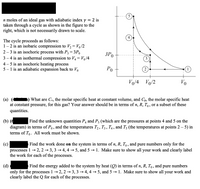Question

Transcribed Image Text:= 2 is
taken through a cycle as shown in the figure to the
right, which is not necessarily drawn to scale.
n moles of an ideal gas with adiabatic index Y
The cycle proceeds as follows:
1– 2 is an isobaric compression to V2= Vo/2
2 – 3 is an isochoric process with P3 = 3P0
3 – 4 is an isothermal compression to V4 = Vo/4
4 – 5 is an isochoric heating process
5 – 1 is an adiabatic expansion back to Vo
ЗРо
Ро
Vo/4 Vo/2
Vo
(a)
at constant pressure,
What are Cv, the molar specific heat at constant volume, and Cp, the molar specific heat
for this gas? Your answer should be in terms of n, R, T , or a subset of these
quantities.
(b) (
diagram) in terms of Po, and the temperatures T,, T3 , T4 , and T3 (the temperatures at points 2 – 5) in
terms of To. All work must be shown.
Find the unknown quantities P4 and P5 (which are the pressures at points 4 and 5 on the
(c)
Find the work done on the system in terms of n, R, T, , and pure numbers only for the
3, 3 → 4, 4 → 5, and 5 → 1. Make sure to show all your work and clearly label
processes 1
the work for each of the processes.
2, 2
Find the energy added to the system by heat (Q) in terms of n, R, T,, and pure numbers
5, and 5 → 1. Make sure to show all your work and
only for the processes 1→ 2, 2 → 3, 3 → 4, 4
clearly label the Q for each of the processes.
Expert Solution
This question has been solved!
Explore an expertly crafted, step-by-step solution for a thorough understanding of key concepts.
This is a popular solution
Trending nowThis is a popular solution!
Step by stepSolved in 4 steps with 4 images

Knowledge Booster
Similar questions
- Please asaparrow_forwardA monatomic ideal gas is initially in state A. The gas undergoes a transition from state A by the three different processes shown, where process III is isothermal. In which process is energy added to the gas by heating? Explain briefly.arrow_forward5:59 PM Thu Apr 29 L 40% O Submit Problem 2 Unanswered An engine runs with an intake temperature of TH = 450K and exhaust temperature of Tc = 300K. The engine's manufacturer claims the engine has an efficiency of 30%. Which of the following statements is correct?- The claimed efficiency is bogus because it violates the 2nd law of A thermodynamics. The claimed efficiency does not violate the 2nd law of thermodynamics. Submitarrow_forward
- View Policies Current Attempt in Progress Air is compressed in a piston-cylinder assembly from p₁ = 25 lbf/in², T₁ = 500°R, V₁ = 9 ft³ to a final volume of V₂ = 1 ft3 in a process described by pv¹.25 = constant. Assume ideal gas behavior and neglect kinetic and potential energy effects. Using constant specific heats evaluated at T₁, determine the work and the heat transfer, in Btu.arrow_forwardProblem #2: For this problem, one mole of a diatomic ideal gas is taken around a reversible cycle by starting at pressure P, volume V, and temperature T, then in an isochoric process 1 increasing pressure to 6P, then in an isobaric process 2 increasing its volume to 21V, then another isochoric process 3 back to a pressure P, and finally in an isobaric process 4 back to P, V, T. Find the temperature of this gas at the end of process 1, 2, and 3 in terms of the original temperature T. Find the internal energy change in process 1 and in process 2 in terms of P and V. Find the heat transfer in process 1 and in process 2 in terms of P and V.arrow_forward1 mole of monatomic ideal gas initially at a volume of 2 L and a pressure of 10 atm is processed through a cycle where it first expands isothermally and reversibly to a final pressure of 2.5 atm, is then reversibly and isochorically cooled to a final temperature of 97.32 K, and then is reversibly and adiabatically compressed back to the initial state. 1. Determine the total work for the cycle 2. Determine change in internal energy for the cyclearrow_forward
arrow_back_ios
arrow_forward_ios